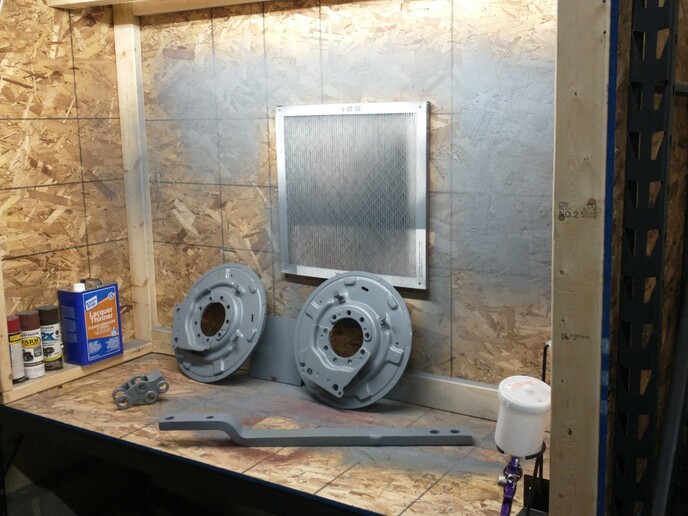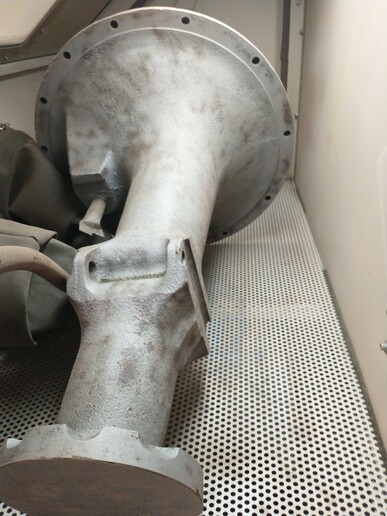I'm tearing my Ford 860 down for a complete rebuild starting with the rear end. My preference would be to sandblast the major parts and prime them. Then when the tractor is reassembled I'll put on a second coat of primer to touch up bolts and scratches, and final paint. I'm curious what others do, what products they use, how long can I go between sandblasting to primer? I've heard that there are product to treat bare metal and go longer without primer. Is that an option to delay primer and paint until the tractor is reassembled since it is in a heated garage. I haven't done any paint work (other than rattle can), so I'm looking for ideas and suggestions.
You are using an out of date browser. It may not display this or other websites correctly.
You should upgrade or use an alternative browser.
You should upgrade or use an alternative browser.
- Thread starter duckrock
- Start date
showcrop
Well-known Member
I used the procedure that they used t the factory. I removed all the sheet metal including the seat, and the radiator, wheels, steering wheel, all control rods and wires. I then cleaned it all with a cup type twisted wire wheel and a flap disc. I then put rust converter on rusty areas, then wire wheeled those areas, and then wiped it down with final prep. Next I sprayed with two coats of epoxy primer, then four coats of vermillion. I did the sheet metal separately as at the factory, then bolted it on. very few bolts to do separately.






Be very cautious about sandblasting anything around moving parts, like bearings and an engine, because the sand gets EVERYWHERE. Sandblasting is okay for individual small parts. Cleanliness is next to godliness, so powerwash, degrease, wire-wheel, de-rust and clean again and again with old-fashioned Dupont Prep-Sol or equivalent. Use a metal etch treatment and/or self-etching primer before proceeding with any subsequent primer and topcoat.
Sand in bearings isn't a concern because the bearing/seals will be removed and replaced. You've got me rethink the process. I might get the majority off now with wire wheel and pressure washing. The do it again when it all assembled and ready for paint
I'll check into the prep-sol you suggested.
I'll check into the prep-sol you suggested.
showcrop
Well-known Member
(quoted from post at 18:04:28 01/18/23) Was your goal to remove all existing paint
down to bare metal, or did you just get
loose paint off?
I didn't take it all down to bare metal. However, I went over every square 1/4 inch with some sort of abrasive. I used my Dremel to get into a lot tight places. If existing paint was still tightly adhered with no cracks I just roughened it. I have had various used tractors and implements that had been previously repainted without priming. The new paint appeared to have caused the original paint to curl and crack and lift. The primer prevents this. I strongly recommend the use of a flap wheel on rusty areas. It will remove the rust much faster than a wire wheel, and while a wire wheel will smooth some rust and make it look like bare metal the flap wheel will completely remove it. Don't skip the rust converter!
Stephen Newell
Well-known Member
Sand is difficult to control and clean off after the fact. It sometimes wedges itself into small spots where you need a pick to get it loose. I think you would be better off sandblasting first and then tear it down. Any missed spots could be cleaned with a wire wheel or hand sanding. If you got sand wedged in a small spot on the inside it might come loose and do damage.
showcrop
Well-known Member
Sandblasting comes up here a few times a year. My take on it is that if you remove parts and blast them separately and then prep for paint that is OK. If you blast assemblies, and there are any seals on those assemblies, and you use the unit you will be replacing the seals in a few years.
Years ago I had a commercial soda blasting set up. I know how nice a job they can do. I spent a few minutes tonight cleaning the left trumpet while it is removed. Cleaning with a flap wheel and wire wheel is not bad when the parts are sitting on a bench and can be rotated all around.
Have no idea. Years ago fertilzer was bought in bulk on bed of truck. Had to get up on truck and fill buckets and get down and take the buckets to planter and dump. Had a bunch af 5 gallon buckets from paint but that paint was dried on so thick it made the buckets extra heavy to carry so I had them blasted and then just a light coat of paint to keep from rusting away before next planting season. Finally got auger to fill planter. Was so much easier on bad body. All the sand blasting I had done.
catalina0029
Member
I am doing the same thing. I'm planning on getting all of the pieces clean to bare metal and put together with a rattle can primer. When I'm ready to paint, there is a fella close by that down does soda blasting. I plan on having him blast off all the primer and then spray on two coats of epoxy primer, that same day. Hopefully it will work.
I thought I had a good plan in place. I have the first few parts blasted to bare metal and shot with epoxy primer. My plan was to get the whole tractor assembled then spray the top coat. But, I stopped at the paint store yesterday and found out the top coat needs to be sprayed within 3 days or the primer needs to be scuffed, re-sprayed, and top coat applied. Essentially redoing all the paint work. My new dilemma is that once the tractor is assembled with painted parts; what needs to be done to paint bolts and/or touch up scratches? Can I respray the whole tractor? Would the top coat need to be scuffed too? I just don't know enough about painting. Guess I'm headed back to the paint store to ask more questions. I was able to find PPG's paint code in the forums, so I'm going to spend a few dollars to get a spray can mixed up to test the color.
showcrop
Well-known Member
(quoted from post at 09:38:09 03/05/23) I thought I had a good plan in place. I have the first few parts blasted to bare metal and shot with epoxy primer. My plan was to get the whole tractor assembled then spray the top coat. But, I stopped at the paint store yesterday and found out the top coat needs to be sprayed within 3 days or the primer needs to be scuffed, re-sprayed, and top coat applied. Essentially redoing all the paint work. My new dilemma is that once the tractor is assembled with painted parts; what needs to be done to paint bolts and/or touch up scratches? Can I respray the whole tractor? Would the top coat need to be scuffed too? I just don't know enough about painting. Guess I'm headed back to the paint store to ask more questions. I was able to find PPG's paint code in the forums, so I'm going to spend a few dollars to get a spray can mixed up to test the color.
I thought that my procedure worked pretty well.
(quoted from post at 11:42:51 03/05/23)(quoted from post at 09:38:09 03/05/23) My new dilemma is that once the tractor is assembled with painted parts; what needs to be done to paint bolts and/or touch up scratches? Can I respray the whole tractor?
It's known as cutting in. Just painting areas not accessible prior to assembly. Assemble then paint as a whole. Scuffing prior painted areas makes sense. Epoxy undercoat does tend to chalk left exposed. Depends on conditions.
showcrop
Well-known Member
(quoted from post at 14:02:27 03/05/23)(quoted from post at 11:42:51 03/05/23)(quoted from post at 09:38:09 03/05/23) My new dilemma is that once the tractor is assembled with painted parts; what needs to be done to paint bolts and/or touch up scratches? Can I respray the whole tractor?
It's known as cutting in. Just painting areas not accessible prior to assembly. Assemble then paint as a whole. Scuffing prior painted areas makes sense. Epoxy undercoat does tend to chalk left exposed. Depends on conditions.
One of my old Fords had a very noticeable shadow on the block behind the starter where there was very little paint.
I'd like to paint mine like you did. But, I don't see how that is possible. Friday night I primed the backing plates; Saturday morning I sand blasted the left
trumpet; then I learned about the 3 day time limit to top coat the primer. I'm probably over thinking it. I just know that I can't leave parts in bare metal for
months until I have the tractor re-assembled and my original plan to primer now and paint later doesn't work.


trumpet; then I learned about the 3 day time limit to top coat the primer. I'm probably over thinking it. I just know that I can't leave parts in bare metal for
months until I have the tractor re-assembled and my original plan to primer now and paint later doesn't work.


Similar threads
- Replies
- 4
- Views
- 1K
We sell tractor parts! We have the parts you need to repair your tractor - the right parts. Our low prices and years of research make us your best choice when you need parts. Shop Online Today.
Copyright © 1997-2024 Yesterday's Tractor Co.
All Rights Reserved. Reproduction of any part of this website, including design and content, without written permission is strictly prohibited. Trade Marks and Trade Names contained and used in this Website are those of others, and are used in this Website in a descriptive sense to refer to the products of others. Use of this Web site constitutes acceptance of our User Agreement and Privacy Policy TRADEMARK DISCLAIMER: Tradenames and Trademarks referred to within Yesterday's Tractor Co. products and within the Yesterday's Tractor Co. websites are the property of their respective trademark holders. None of these trademark holders are affiliated with Yesterday's Tractor Co., our products, or our website nor are we sponsored by them. John Deere and its logos are the registered trademarks of the John Deere Corporation. Agco, Agco Allis, White, Massey Ferguson and their logos are the registered trademarks of AGCO Corporation. Case, Case-IH, Farmall, International Harvester, New Holland and their logos are registered trademarks of CNH Global N.V.
Yesterday's Tractors - Antique Tractor Headquarters
Website Accessibility Policy

